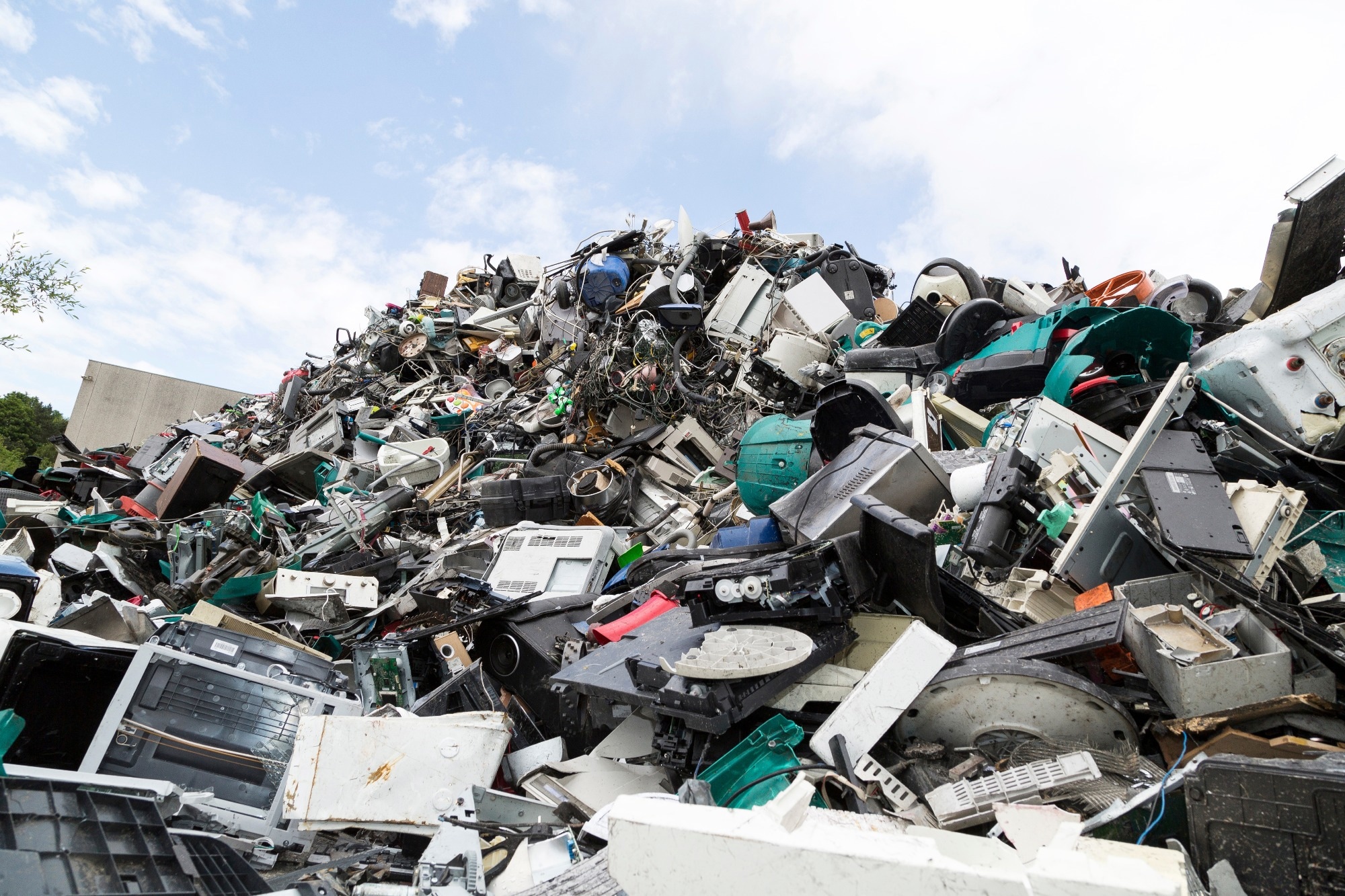A new study reveals that children in e-waste regions face a fourfold higher risk of hypertension, as toxic metals and VOCs alter gut-related metabolic pathways and disturb the body’s blood pressure regulation.
 Study: Exploring the Impact of E-Waste Exposure on Childhood Blood Pressure: Metabolomics Analysis and Risk Prediction. Image credit: Morten B/Shutterstock.com
Study: Exploring the Impact of E-Waste Exposure on Childhood Blood Pressure: Metabolomics Analysis and Risk Prediction. Image credit: Morten B/Shutterstock.com
In a recent article in Environment & Health, researchers examined how children’s blood pressure is affected by their exposure to heavy metals and volatile organic compounds (VOCs) from electronic waste (e-waste) recycling.
They found that children living in areas with e-waste showed elevated levels of VOCs and metal(loid)s and were about four times more likely to have hypertension (12.7% vs. 3.1% nationally), highlighting the risks of e-waste exposure during childhood.
Background
The global rise in e-waste has led to widespread environmental contamination and growing health risks, particularly in recycling regions where toxic substances are released during dismantling and burning processes.
Hypertension remains a leading modifiable risk factor for heart and brain diseases, yet traditional factors do not fully explain its increasing prevalence. Studies have shown that people living near e-waste sites experience higher rates of hypertension, including children, whose early blood pressure elevation can increase their lifelong cardiovascular risks.
VOCs and metal(loid)s are major pollutants from e-waste recycling and are known to harm the cardiovascular system. Their combined exposure may interact through shared oxidative stress pathways or chemical reactions, intensifying toxicity.
However, previous studies often focused on a few pollutants and lacked insight into how mixed exposures affect children’s blood pressure. Moreover, the biological mechanisms behind these effects are poorly understood due to the limited scope of conventional biomarkers. Advances in metabolomics offer a comprehensive way to assess metabolic disturbances from environmental exposure.
About the study
This study, which integrated urinary metabolomics with machine learning, aimed to clarify how VOC and metal(loid) co-exposure affects children’s blood pressure and develop a predictive model for identifying those at risk of hypertension.
The study was conducted in October 2022 among 426 children living in an e-waste recycling area in China with no history of hypertension. Researchers collected fasting urine samples and blood pressure measurements. Children’s demographic and health data were recorded through questionnaires.
Urine samples were analyzed for 18 metal(loid)s, including lead, nickel, cadmium, and arsenic, using inductively coupled plasma mass spectrometry (ICP–MS) and for 15 VOC metabolites (mVOCs) (such as benzene and styrene derivatives) using ultrahigh performance liquid chromatography coupled with tandem mass spectrometry (UHPLC–MS/MS). Rigorous quality controls ensured measurement accuracy.
Untargeted urinary metabolomics was performed with high-resolution mass spectrometry to profile over 180 metabolites. Data were processed and annotated using specialized software to identify exposure-related metabolic changes.
Blood pressure was measured with an automatic monitor following standard pediatric guidelines. Hypertension is defined as values at or above the 95th percentile for height, age, and sex.
Statistical analyses included multiple linear regression and principal component analysis to assess exposure-blood pressure associations. Metabolome-wide association studies (MWAS) and machine learning algorithms were applied to identify key metabolic predictors and to classify children with potential hypertension risk with up to 83% accuracy.
Key findings
Despite a decline in most pollutant levels compared with previous e-waste region data, several mVOCs remained elevated, with mean concentrations of some exceeding those in children from other Chinese regions, while metal(loid) levels such as rubidium, strontium, and arsenic were higher than in children or workers from other countries.
A hypertension prevalence of 12.7%, notably higher than national estimates, was recorded, suggesting ongoing health risks. Statistical analyses identified significant associations between certain exposures and blood pressure. For example, urinary cobalt and gallium were positively associated with systolic blood pressure, while selenium and tin correlated with diastolic blood pressure.
Principal component analysis revealed that a mixture of three metabolites was significantly linked to increased systolic and diastolic blood pressure, implicating VOCs as key contributors.
Metabolomic analysis showed altered amino acid, fatty acid, and steroid pathways, with metabolites like l-glutamine, creatine, and N-phenylacetyl-l-glutamine (PAGln) involved. Notably, higher PAGln levels were inversely associated with blood pressure, suggesting potential metabolic regulation mechanisms in pollutant-induced hypertension. The study also identified pyroglutamic acid as another metabolite linked to blood pressure changes, indicating that gut microbiota metabolism and γ-glutamyl cycling may play key roles in these effects.
Conclusions
This study provides new evidence linking VOC and metal(loid) exposure to increased blood pressure in children, consistent with adult findings. Mechanistically, pollutants like benzene and styrene may elevate blood pressure through oxidative stress, endothelial dysfunction, and neuroendocrine imbalance. The findings further suggest that disrupted gut microbiota metabolism and γ-glutamyl cycling could underlie pollutant-related hypertension.
The results also reveal novel associations between nonessential elements such as tin and gallium and childhood blood pressure, highlighting the complex toxicity of pollutant mixtures.
Strengths include comprehensive exposure assessment, integration of metabolomics, and mixture modeling, which clarify potential pathways connecting environmental pollutants to cardiovascular risk. However, the cross-sectional design prevents causal inference, and the lack of detailed exposure source data limits generalizability.
In conclusion, children in e-waste processing areas remain exposed to harmful levels of mVOCs and metal(loid)s, which may contribute to hypertension development. Future longitudinal and mechanistic studies are needed to confirm causality and guide targeted interventions to reduce exposure, particularly from e-waste and plastic recycling activities.
Download your PDF copy now!
Journal reference:
- Li, M., Chen, T., Liu, Y., Xiang, M., Kuang, H., Yu, Y. (2025). Exploring the Impact of E-Waste Exposure on Childhood Blood Pressure: Metabolomics Analysis and Risk Prediction. Environment & Health. DOI: 10.1021/envhealth.5c00189. https://pubs.acs.org/doi/10.1021/envhealth.5c00189